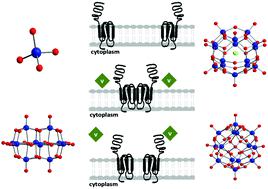当前位置:
X-MOL 学术
›
Metallomics
›
论文详情
Our official English website, www.x-mol.net, welcomes your
feedback! (Note: you will need to create a separate account there.)
Polyoxometalates function as indirect activators of a G protein-coupled receptor.
Metallomics ( IF 2.9 ) Pub Date : 2020-05-18 , DOI: 10.1039/d0mt00044b Duaa Althumairy 1 , Kahoana Postal 2 , B George Barisas 3 , Giovana G Nunes 4 , Deborah A Roess 5 , Debbie C Crans 3
Metallomics ( IF 2.9 ) Pub Date : 2020-05-18 , DOI: 10.1039/d0mt00044b Duaa Althumairy 1 , Kahoana Postal 2 , B George Barisas 3 , Giovana G Nunes 4 , Deborah A Roess 5 , Debbie C Crans 3
Affiliation

|
The luteinizing hormone receptor (LHR), a G protein-coupled receptor (GPCRs), can initiate signaling in the presence of some vanadium-containing compounds as a result of vanadium compound interactions with the membrane lipids and/or the cell membrane lipid interface. The ability of LHR expressed in CHO cells to initiate signaling in the presence of highly charged and water-soluble polyoxovanadates (POV) including Na3[H3V10O28] (V10) and two mixed-valence heteropolyoxovanadates, K(NH4)4[H6V14O38(PO4)]·11H2O (V14) and [(CH3)4N]6[V15O36(Cl)] (V15), was investigated here. Interactions of the vanadium compounds with CHO cells decreased the packing of membrane lipids, drove aggregation of LHR and increased signal transduction by LHR. Cell responses were comparable to, or in the case of V14 and V15, greater than those seen for cells treated with human chorionic gonadotropin (hCG), a naturally-occurring LHR ligand produced in early pregnancy in humans. POV effects were observed for CHO cells where LHR was expressed at 10 000 or 32 000 LHR per cell but not when LHR was overexpressed with receptor numbers >100 000 LHR per cell. To determine which POV species were present in the cell medium during cell studies, the speciation of vanadate (V1), V10, V14 or V15 in cell medium was monitored using 51V NMR and EPR spectroscopies. We found that all the POVs initiated signaling, but V15 and V10 had the greatest effects on cell function, while V1 was significantly less active. However, because of the complex nature of vanadium compounds speciation, the effects on cell function may be due to vanadium species formed in the cell medium over time.
中文翻译:

多金属氧酸盐用作 G 蛋白偶联受体的间接激活剂。
由于钒化合物与膜脂和/或细胞膜脂界面的相互作用,促黄体激素受体 (LHR) 是一种 G 蛋白偶联受体 (GPCR),可在某些含钒化合物存在时启动信号传导。在 CHO 细胞中表达的 LHR 在存在高电荷和水溶性多氧钒酸盐 (POV) 的情况下启动信号传导的能力,包括 Na 3 [H 3 V 10 O 28 ] ( V 10 ) 和两种混合价杂多氧钒酸盐K(NH 4 ) 4 [H 6 V 14 O 38 (PO 4 )]·11H 2 O (V 14 ) 和 [(CH 3 ) 4 N] 6 [V 15 O 36 (Cl)] ( V 15 ),在这里进行了研究。钒化合物与 CHO 细胞的相互作用减少了膜脂的堆积,推动了 LHR 的聚集并增加了 LHR 的信号转导。细胞反应与V 14和V 15相当,或者就V 14和V 15 而言,大于用人绒毛膜促性腺激素 (hCG) 处理的细胞所见,这是一种在人类怀孕早期产生的天然 LHR 配体。在 CHO 细胞中观察到 POV 效应,其中 LHR 以每细胞 10 000 或 32 000 LHR 表达,但当 LHR 过表达且受体数量 > 100 000 LHR 每细胞时则不然。为了确定细胞研究期间细胞培养基中存在哪些 POV 种类,使用51 V NMR 和 EPR 光谱监测细胞培养基中钒酸盐 ( V 1 )、V 10、V 14或V 15的形态。我们发现所有 POV 都发起了信号传输,但V 15和V 10对细胞功能的影响最大,而V 1 的活性显着降低。然而,由于钒化合物形态的复杂性,对细胞功能的影响可能是由于随着时间的推移在细胞培养基中形成的钒物质。
更新日期:2020-07-22
中文翻译:

多金属氧酸盐用作 G 蛋白偶联受体的间接激活剂。
由于钒化合物与膜脂和/或细胞膜脂界面的相互作用,促黄体激素受体 (LHR) 是一种 G 蛋白偶联受体 (GPCR),可在某些含钒化合物存在时启动信号传导。在 CHO 细胞中表达的 LHR 在存在高电荷和水溶性多氧钒酸盐 (POV) 的情况下启动信号传导的能力,包括 Na 3 [H 3 V 10 O 28 ] ( V 10 ) 和两种混合价杂多氧钒酸盐K(NH 4 ) 4 [H 6 V 14 O 38 (PO 4 )]·11H 2 O (V 14 ) 和 [(CH 3 ) 4 N] 6 [V 15 O 36 (Cl)] ( V 15 ),在这里进行了研究。钒化合物与 CHO 细胞的相互作用减少了膜脂的堆积,推动了 LHR 的聚集并增加了 LHR 的信号转导。细胞反应与V 14和V 15相当,或者就V 14和V 15 而言,大于用人绒毛膜促性腺激素 (hCG) 处理的细胞所见,这是一种在人类怀孕早期产生的天然 LHR 配体。在 CHO 细胞中观察到 POV 效应,其中 LHR 以每细胞 10 000 或 32 000 LHR 表达,但当 LHR 过表达且受体数量 > 100 000 LHR 每细胞时则不然。为了确定细胞研究期间细胞培养基中存在哪些 POV 种类,使用51 V NMR 和 EPR 光谱监测细胞培养基中钒酸盐 ( V 1 )、V 10、V 14或V 15的形态。我们发现所有 POV 都发起了信号传输,但V 15和V 10对细胞功能的影响最大,而V 1 的活性显着降低。然而,由于钒化合物形态的复杂性,对细胞功能的影响可能是由于随着时间的推移在细胞培养基中形成的钒物质。











































 京公网安备 11010802027423号
京公网安备 11010802027423号